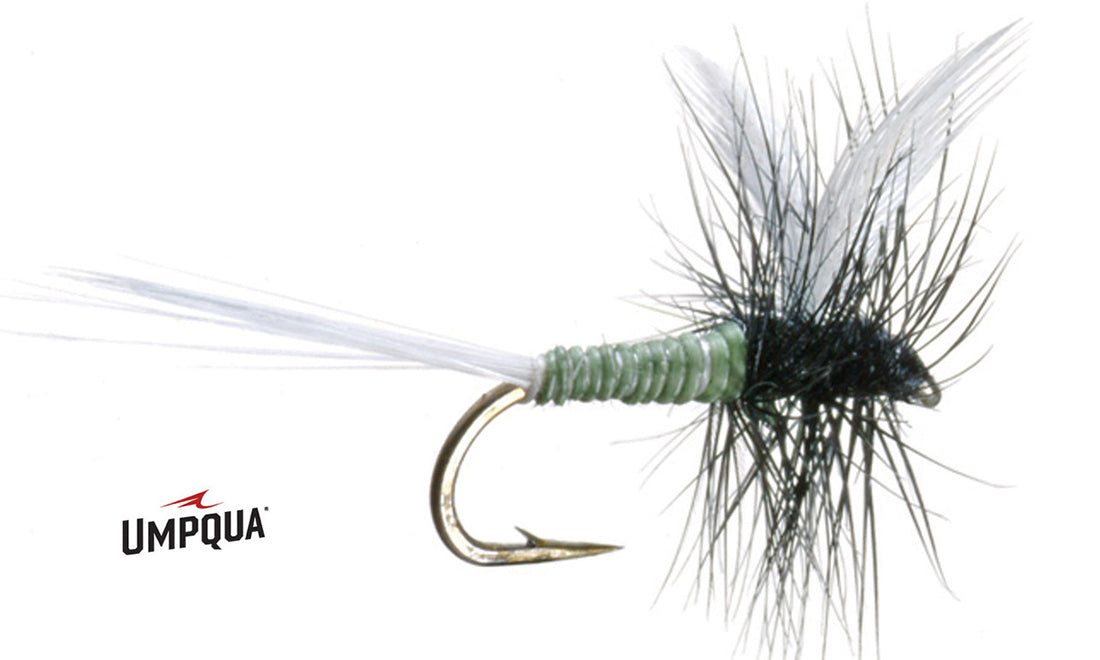Guest Blogger: Joe Dellaria
The first time I saw a Trico spinner fall was mid-July. The good news was, I had read an article and was able to recognize what was going on. The bad news was, I didn’t have any trico spinner flies and watched helplessly while standing in the middle of a trout feeding frenzy. I did manage to entice one nice trout to take a grasshopper. That was a consolation prize as I watched dozens of fish feeding with total abandon within four or five rod lengths. At one point, the spinner fall was so thick, a 20+ inch trout simply opened its mouth and mowed a strip of tricos down the hatch as it swam across the run.

Once again, my lightning quick mind concluded, “Hey, I better learn how to do this.” So, the aim of this article is to arm those who are new to, or have little experience with, the Trico spinner fall so they can join the fun. This is an amazing opportunity for some excellent fly-fishing from early- to mid-July into fall. It definitely requires technical fishing skills, but with a little knowledge and persistence, it can become a steady source of many fish on the end of your line.
The Trico, or Tricorythodes, is a small, actually, very small mayfly that trout absolutely love. The reason is obviously not size of the mayfly it varies between 3-6 mm (3/16” – 5/16”) in length. Trout love the trico because it has a spinner fall that lasts anywhere from a half hour to an hour and a half long. For those in the know, you can easily add an hour of excellent fishing on either end of the spinner fall.
What I would like to share are the basics that will allow anyone to take advantage of the Trico spinner fall. The table below provides the basics of how to fish the Trico spinner fall:
Trico Spinner Fall Timeline
| What Happens | What I do | |
| 1 | Males hatch at night. | Nothing, get more sleep. It’s hard enough to hook a trout on a #18-#22 hook when you can see it. At night, it’s virtually impossible (at least for me). |
| 2 | When the air temperature reaches around 65 degrees, females begin to hatch. Some trout will feed on the hatching females. | Use a two-fly rig with #16 Parachute Adams or BWO with a #16 beadhead Pheasant Tail or Prince (or your favorite local pattern) |
| 3 | Eventually the males and females meet in the air to mate. In a good year, you can visibly see mating swarms in balls several feet in diameter. This means the spinner fall will start within an hour or less. | Keep fishing the two-fly rig. Eventually, the fish will stop taking either fly. It will be very obvious.When that happens, switch out the nymph dropper, for a male trico spinner. I start with 5x tippet on the dropper. If I get two or more refusals, I drop to 6x. Still more refusals, drop to 7x. |
| 4 | After mating, the male duns will molt and drop as spinners on the water first. Fish will set up in feeding lanes. | Now the fun begins. Start casting to the most downstream and closest fish to your side of the stream. You need to time your cast to the fish’s rises so your fly is floating by when it is about time for the fish to take again. Keep casting to that fish until you either hook it, or it stops rising.Cast to the next fish across the stream until you either hook it, or it stops rising.Once you work across the stream and run out of fish, take a few steps upstream and repeat the above process. |
| 5 | The females will deposit their eggs, molt, and fall as spinners after the males. At times both males and females can be on the water at the same time. | Some people claim they have never seen trout be selective between males (black body, black abdomen) and females (white or pale green body, black abdomen). I find the trout to be selective on my streams.If the trout are selective, you will stop getting takes on the male trico fly. Switch to the female |
| 6 | For the first week or two of the trico spinner fall, the fish feed voraciously (If you clean a fish their intestines and stomach will look like and over-stuffed sausage). As one of my friends puts it, “The fish get rock stupid dumb!” | During this time, you may be able to catch several fish out of a heavily feeding pod of fish. You can drag a hooked trout right through the middle of the feeding frenzy with no apparent effect. As the season progresses, fish will get more wary. Picking off the most downstream fish will become increasingly necessary if you want to catch more fish. |
| 7 | Eventually there are very few spinners on the water. There are always a few diehards looking for the last morsel. | You can still pick these fish off but your approach must be increasingly stealthy and small casting errors will often put the fish down. |
| 8 | Fish will stop rising completely. | Bummer, but not to worry. You can switch out your floating spinner fly for a drowned trico pattern and dead drift it through riffles and other areas where you were catching fish earlier for up to 2 hours (so they say). I find this to be effective for 30 minutes and sometimes for an hour. |
It’s Air Temperature Not Time of Day: Many people want to know what time they need to be on the water. The spinner fall is driven by air temperature. In July and August, the evening low might be in the mid-70s. When that happens, you may catch the tail end of the spinner fall if you show up at sun up. In late August and September, the air temperature usually reaches 65 between 9-11 a.m. Later in the season, it could be later. This year, we had a cold snap in August and I saw my first trico spinner fall in the evening!
Stealth Become Increasingly Important As The Season Progresses: Initially the trout are ravenous during the first week or two. In addition, the fishing pressure will steadily increase as the word gets out the trico fall is on. Consequently, the fish get pickier on the fly pattern and less forgiving on sloppy casting and noisy approaches.
Break-offs Are Inevitable: If you are lucky, you can get by with a 5x tippet, especially during the first week or two of the spinner fall. Eventually you will have to drop to 6x to get takes. If the water is very clear and slow, 7x may be necessary. The fish know how to break your line in certain stretches. As soon as you hook them, they will put their heads in the gravel bottom and thrash their heads back and forth until they break you off. When you get down to 7x, it is a real chess match. You want to get their heads up to keep them from the bottom, but if it’s a bigger fish, you may break them off trying to get their head up. I would rather break them off trying to get their head up then let them get to the gravel bottom where it is virtually assured they will break you off.
Equipment for the Trico Spinner Fall
Equipment Needs:
- Rod: use one you can cast accurately in the 15-40 foot range.
- Leader: I start with a minimum of a 9 foot tapered 5x leader. If I get refusals, I add on 2-3 feet of 6x tippet. If they are still refusing, drop to 7x.
- As the season progresses I usually start with a 12 foot 5x leader. The fish get increasingly picky.
-
Flies– make sure you have 3-4 male and female patterns. I like to have 2-3 different types of wing material and body types. Sometimes the difference can be amazing. Remember, you will get broken off, that’s why you need 3-4 of each pattern.
- Male patterns: 2-3 tail fibers, black body, black abdomen, spent wing material
- Female patterns: 2-3 tail fibers, white or pale green body, black abdomen, spent wing material
- If you tie your own, you can find patterns on the internet.
- If you want to purchase them, your local fly shop and numerous internet sites can provide a nice variety of “styles”
- Every year it seems like a different “style” works better than others do. Don’t be afraid to try different styles as well.
- The drowned trico is very easy to tie. Add an appropriately sized glass bead and tie a female (white body, black abdomen). Tie the wings angled back at ~45 degrees. It is pretty easy to find a recipe on the internet.
-
Hook size – The flies are generally best imitated by #20-24 (or smaller) hook sizes. I always start with one hook size larger than the flies on the water. Use the biggest fly fish will take. You will land more fish. If the fish are not even looking at your fly it is either too large or your tippet is too heavy. I usually drop one hook size first (it’s faster to retie one fly). If the fish still don’t look at your fly, drop down one tippet size. Keep dropping your fly and tippet size until you get takes.
- The size of the fly can be very important. These are small flies. If the naturals are 3 mms long and you are using a 4 mm imitation, the fish see a 30% larger fly. That is enough to keep them from taking the fly.
- I started using Daiichi 1130 and Daiichi 1140, or Tiemco 2487 hooks. They have a wide gape and 1x fine hook. This gives you more hook setting ability. In addition, I tie most of my trico patterns on a size #18 hook but tie #20 or 22 size bodies. The flies don’t float as well, so you have to use floatant more often, but I lose fewer fish.
- Floatant – use whatever you like, I find the dry powder (Frog’s Fanny and the like) works best, but rub on liquid floatants work well too.
Well, that’s it. This should get you going. Feel free to contact me if you have any questions. This is definitely a challenging way to catch trout. However, landing upper teens trout on a #18-20 hook with 5-6X tippet is a real achievement. So go get em! This is a true test of your fishing abilities.

